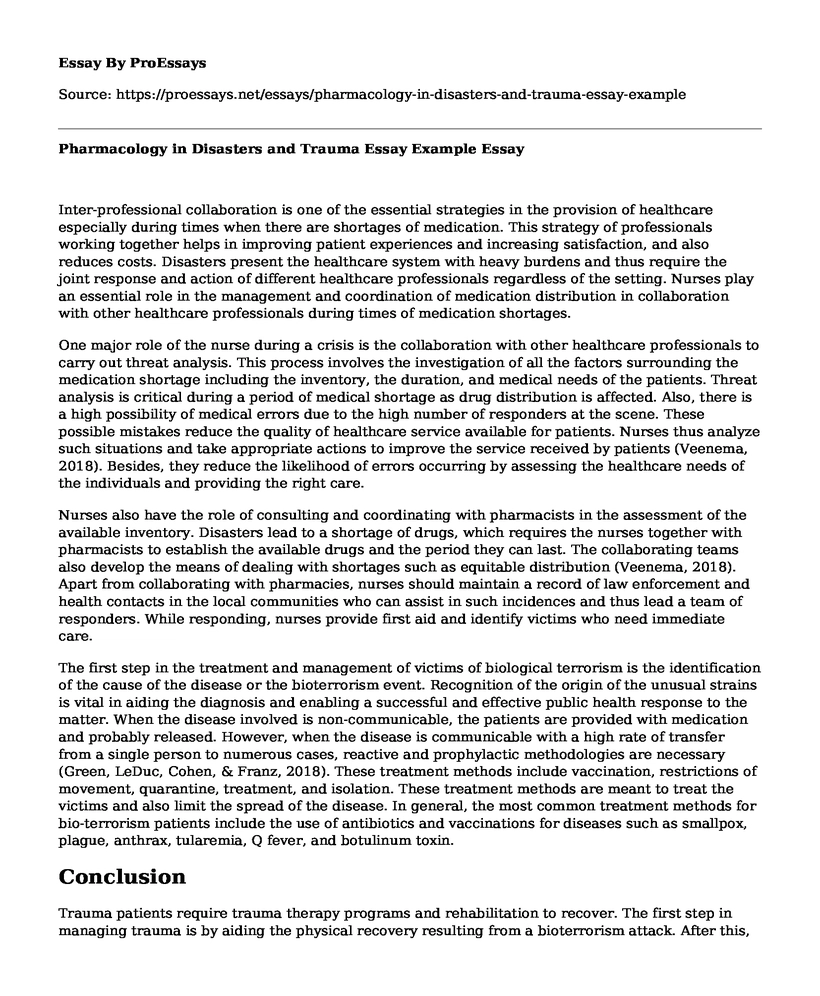Inter-professional collaboration is one of the essential strategies in the provision of healthcare especially during times when there are shortages of medication. This strategy of professionals working together helps in improving patient experiences and increasing satisfaction, and also reduces costs. Disasters present the healthcare system with heavy burdens and thus require the joint response and action of different healthcare professionals regardless of the setting. Nurses play an essential role in the management and coordination of medication distribution in collaboration with other healthcare professionals during times of medication shortages.
One major role of the nurse during a crisis is the collaboration with other healthcare professionals to carry out threat analysis. This process involves the investigation of all the factors surrounding the medication shortage including the inventory, the duration, and medical needs of the patients. Threat analysis is critical during a period of medical shortage as drug distribution is affected. Also, there is a high possibility of medical errors due to the high number of responders at the scene. These possible mistakes reduce the quality of healthcare service available for patients. Nurses thus analyze such situations and take appropriate actions to improve the service received by patients (Veenema, 2018). Besides, they reduce the likelihood of errors occurring by assessing the healthcare needs of the individuals and providing the right care.
Nurses also have the role of consulting and coordinating with pharmacists in the assessment of the available inventory. Disasters lead to a shortage of drugs, which requires the nurses together with pharmacists to establish the available drugs and the period they can last. The collaborating teams also develop the means of dealing with shortages such as equitable distribution (Veenema, 2018). Apart from collaborating with pharmacies, nurses should maintain a record of law enforcement and health contacts in the local communities who can assist in such incidences and thus lead a team of responders. While responding, nurses provide first aid and identify victims who need immediate care.
The first step in the treatment and management of victims of biological terrorism is the identification of the cause of the disease or the bioterrorism event. Recognition of the origin of the unusual strains is vital in aiding the diagnosis and enabling a successful and effective public health response to the matter. When the disease involved is non-communicable, the patients are provided with medication and probably released. However, when the disease is communicable with a high rate of transfer from a single person to numerous cases, reactive and prophylactic methodologies are necessary (Green, LeDuc, Cohen, & Franz, 2018). These treatment methods include vaccination, restrictions of movement, quarantine, treatment, and isolation. These treatment methods are meant to treat the victims and also limit the spread of the disease. In general, the most common treatment methods for bio-terrorism patients include the use of antibiotics and vaccinations for diseases such as smallpox, plague, anthrax, tularemia, Q fever, and botulinum toxin.
Conclusion
Trauma patients require trauma therapy programs and rehabilitation to recover. The first step in managing trauma is by aiding the physical recovery resulting from a bioterrorism attack. After this, the care program focuses on the psychological health of the victim. The most common psychological effects of trauma from an act of terrorism include post-traumatic stress disorder (PTSD), depression, and extreme fear (Maercker, & Hecker, 2016). Therapeutic methods and group therapy are necessary for helping the victim overcome the psychological effects of trauma. However, the recovery process might take a long time.
References
Green, M. S., LeDuc, J., Cohen, D., & Franz, D. R. (2018). Confronting the threat of bioterrorism: realities, challenges, and defensive strategies. The Lancet Infectious Diseases.
Maercker, A., & Hecker, T. (2016). Broadening perspectives on trauma and recovery: A socio-interpersonal view of PTSD. European journal of psychotraumatology, 7(1), 29303.
Veenema, T. G. (Ed.). (2018). Disaster nursing and emergency preparedness. Springer Publishing Company.
Cite this page
Pharmacology in Disasters and Trauma Essay Example. (2022, Nov 20). Retrieved from https://proessays.net/essays/pharmacology-in-disasters-and-trauma-essay-example
If you are the original author of this essay and no longer wish to have it published on the ProEssays website, please click below to request its removal:
- Research Paper on Engaging Parents With Children
- Research Paper on What is Cushing's Syndrome?
- Essay Sample on Professional Presence and Influence in Nursing Practice
- Should Smoking in the Public Be Allowed? - Essay Sample
- Argumentative Essay on Curiosity in Science
- Essay Sample on Sporting Risk Management Decisions
- Essay Sample on Fisher's Speech on AIDS: A Whisper of Change at RNC 1992







